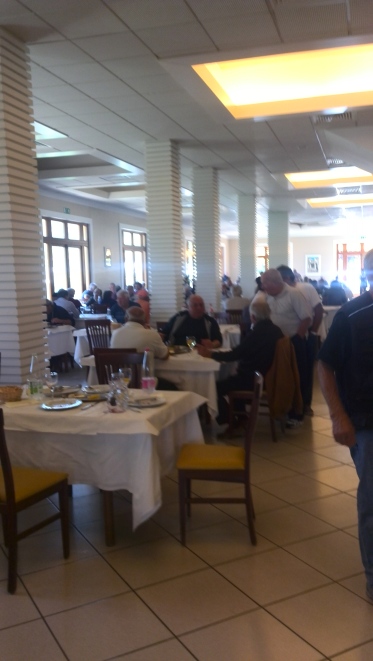Good eating is extremely important in Le Marche, as in all of Italy, and you often hear the phrase “In Italia, si mangia bene, si spende poco” – “In Italy one eats well, one spends little”. The Slow Food movement began in Italy, with the belief that locally grown organic food is so much better than any alternative. And these sweet hills grow an amazing amount of food for local consumption. 
Even in rural southern Le Marche, there is too much choice really. We eat out a lot. There are several levels of ‘ristoranti’ ( and they DO restore you) all providing excellent food and wine, and for an easy and economical choice we often head with a group of friends to a family-run spacious workers’ restaurant that offers ‘menu fisso’ or ‘set menu’.
‘Menu fisso’ means there is no written menu, and usually only little choice, but you can be assured of healthy home-styled food, everything being prepared from scratch by the older women in the family who really do know what they are doing. It is completely different to the dismal ‘menu turistico’ that is offered in touristy cities.
At these wonderful establishments the cost of a full meal including wine is usually 10 euro per head, but can be up to 15 euro, especially if it includes elaborate antipasti or seafood served fresh on the coast.
Nobody speaks English here, and with no written menus, it can be a little intimidating. So I will now walk you through a normal fixed menu lunch at one of these popular venues. No booking is necessary, there are plenty of set tables every day.

First you will notice there a smart shiny setting and fresh clean tablecloth, of course, something that is insisted upon in Italy. Where else will you put the rest of your piece of chunky bread – certainly not back in the bread basket – are you a heathen? Of course not, it sits on the clean cloth in front of your table setting.
The wine is served in glass pitchers, a choice of red or white or both, and bottled mineral water always is provided. Fresh crusty bread arrives in a basket. You now have something to begin with while your dishes are being prepared.
Sometimes, but not always, you will be offered antipasti as part of your set meal, which will always consist of a selection of salumi & cheeses to whet your appetite; and other local specialties like olive ascolane (meat-stuffed olives), coratella ( lemony eggs with chopped liver etc), cave-matured cheeses, farro salad, spiedini and cremini. Add seasonally available treats like truffles, quail eggs, fresh figs. rockmelon, and you are almost full already.
Onto the first course, which is usually fresh-made egg pasta or risotto, with maccheroncini being a popular southern Le Marche specialty (you often see it drying on the tables at the back of the restaurant, as it’s made fresh each day by the experienced hands of the grandmas).

The pasta sauces are made from scratch and are all lip-smackingly delicious. You will most likely get a choice of two pasta dishes. Some restaurants specialise in ‘pasta al forno’ ( oven-cooked pasta like lasagne, cannelloni, fagottini or girelli ). All are superb.
Your second course will be a meat course, although fish is usually served on Fridays. (If you don’t want to eat what’s available, don’t be shy, let the staff know, and they will get the cook to fix you up something more to your liking). This will be accompanied with a contorno, usually a simple salad or other vegetable plate. If you run out of water or wine, ask for a refill, at no extra cost.
Now we finish off with a bowl of fresh fruit, or a dolce (dessert) like tiramisu, crema catalana or squares of cake, and espresso coffee to follow. A flask of home made liqueur – normally the local aniseed flavoured mistra’ – will be brought to your table with your espresso, purely as an aid to your digestion. By the way, anyone ordering a cappucino after 11am in the morning is regarded as requiring urgent psychiatric care – or you could just be a foreigner who doesn’t know any better!
You might think that’s quite a midday meal, but consider that lunch is the main meal of the day, when your metabolism is at it’s peak and very little is required in the evening. It takes a while to get used to the fact that you don’t have to actually eat or drink everything. Lunch usually lasts at least 3 hours when we are eating with friends.
It’s perfectly normal to leave half a jug of wine on the table when you leave. You stop when you have had sufficient. Nobody would think of polishing off the bottle of liquid moonshine either, it’s just not done. Who on earth wants to see a rolling drunk leaving the restaurant? That would be utter madness.

















